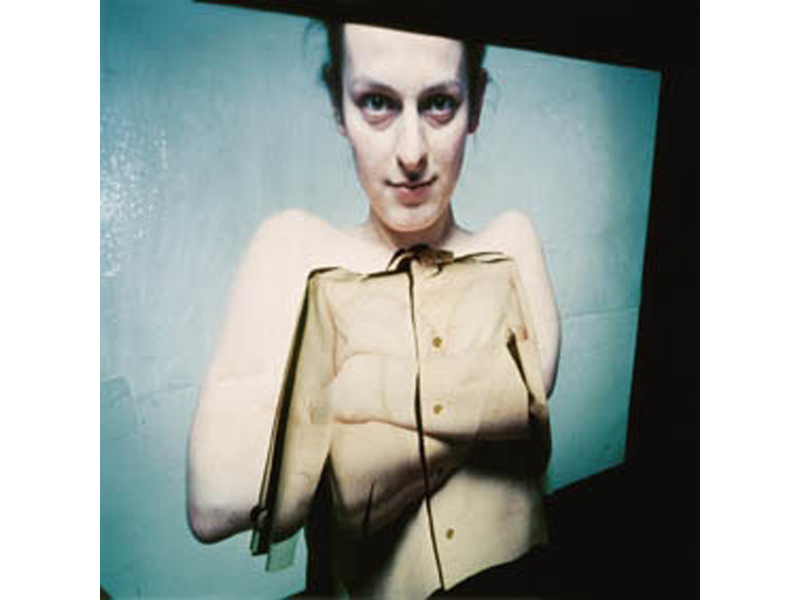EXHIBITION
Strasbourg 2004
Thessaloniki, Szczecin 2005
Within the framework of: Contemporary identities

Artists: Zelda Klimkowska / Sylwia Kowalczyk / Konrad Kuzyszyn / Dominik Pabis / Wojciech Prazmowski / Aneta Grzeszykowska & Jan Smaga / Jerzy Truszkowski / Pawel Zak
Curator: Dimitri Konstantinidis, Anne Laval, en collaboration avec Magdalena Lewoc
Pieces of identity: the title of the exhibition highlights the complexity of the Polish situation, by means of touching and profoundly human works, which remain strangely attractive even in repulsion.
The first attempt to respond to the problem involves artists taking the paths of individual and collective memory to rediscover their identity.
Jerzy Truszkowski, artist, theoretician and performer-agitator, uses images that are on the threshold of bearability. He alternates photos of the corpse of his father with others of his youth, showing that death or physical deterioration inevitably fashion the status of the individual.
On a lighter note, Polish daily life and the landscapes of the country are also the objects of quests for identity. For example, in the “red, black, white” series by Wojciech Prazmowski, the artist focuses his attention on the kitsch aspects of Polish society. Bad taste art joins forces with national architectural and city planning practices and forms a new form of social recognition with which the artists plays.
As for Pawel Zak, he focuses more on the question of individual memory. Various childhood memories are brought together in an unexpected way, in order to recreate a new dreamlike universe. Once again, memory is used as a touchstone in this quest for identity, which is at times personal, at others collective.
It is essentially around the question of the body that this quest for identity seems to crystallise, in the second category of works on display: body of the artist, idealised bodies, body confronted with space, body as merchandise. All of which goes to show that there is nothing to say about the individual and identity without taking the body into account. The close-ups by Dominik Pabis, initially, do not enable the part of the represented body to be identified. Then the eye moves towards the detail, which gives a more global perception.
On the other hand, the naked bodies by Zelda Klimkowska are perfectly identifiable, precisely because of their nakedness. And yet the heads, hooded in paper cones, hide the person’s individual identity. All that remains is the family identity, because it is a couple and their child. The representation of the pregnant woman underlines the image of maternity, one of the very founding stones of traditional Polish society.
The idealised body in the Ken series by Konrad Kuzyszyn denounces the universality of standardised corporal representation, by means of an archetypal model. The rejected individual particularities highlight the process of globalisation which rejects the questions of identity which belong to each country and each culture.
Zelda Klimkowska photographs marginal personalities in their professional or family environment. The characteristic gesture gives each person their own personality, as do the professional attributes, which place them in their social context.
The ninety-one poses of “kate” by Aneta Grzeszykowska and Jan Smaga represent a young blond woman who does not change at all, save for her clothes. The clothes – to use the title of the series – are what defines the individual. It is the clothing, which gives meaning to any identity-based interpretation of the same person, ad infinitum.
Multiplication and splitting are also at work in the series entitled A close acquaintance by Pawel Zak. The mirror does not reflect, but sets up a dialogue with oneself. With a nod and a wink, the artist suggests that there is a gap between an individual and his supposed reflection, as if the “distorting” mirror underlined how impossible it is to understand an identity.
In the last category of works, the artists have chosen to take about identity by placing individuals in direct relation with urban or private environment.
A clear opposition is thus created between public and private space, between the rooms of flats and huge open squares with their impressive monuments.
Sylwia Kowalczyk chooses to bring to life the various rooms in her flat using projections of her portrait or her own body. The space is therefore inhabited by a ghostlike image rather than a reality.
Aneta Grzeszykowska and Jan Smaga work like architects in trying to emphasis the relationships that exist between the individual and the private space. They demonstrate the strong links that exist between people and precise places in their house. Space becomes flat. By eliminating perspectives and providing an aerial view, the spectators are able to grasp the specific relationship between man and his habitat.
Dominik Pabis takes another look at this link in Travel notes and Mystery of space. The artist includes in his composition a part of his body, which serves as a landmark and as a scale for the landscape that is photographed. He plays with the formal similarity that exists between these two elements. In the series Travel Notes, he pursues the experiment and has his fingers dialogue with the urban landscape.
It is this quest, this subtle and sometimes explosive mixture of corporal, spatial and historical identities that the exhibition Pieces of identity demonstrates so clearly.
Piece of identity like a jigsaw puzzle of fragments of history,
Piece of identity, like a passport photo, a projected photo, idealised or impersonal,
Pieces of identity, last of all, like the rooms in a flat, in an architectural element or a public urban space.
The artists exhibited here interpret, question, manipulate and recompose all of these identity-related elements, at times with solemnity, at others with humour and irony, but always with the same objective in mind: understanding and grasping the poetry of the universe which surrounds us.
Dimitri Konstantinidis
Director of apollonia, european art exchanges